Any of my Northeast readers dealing with this unbearable cold and relentless snow the past few weeks will probably cringe a bit when they see how in my sequential retrospective of “Brand New Day” I’ve hit upon this three-part arc by Zeb Wells and Chris Bachalo that deals with Spider-Man fighting a demonic deity in an unseasonable blizzard in NYC. I know a chill ran up my spine as I was re-reading Amazing Spider-Man #555-557, though that could from the wintry freeze blast that whipped across my face as I walked to the subway (before reading the arc on my iPad).
Anyway, what’s more notable about this arc (do any of these “Brand New Day” stories technically have names? I referred to the last three issues as the “Freak” arc and I guess I can just refer to this one as “Blizzard”) is how for the first time since Spider-Man made a deal with the devil over the state of his marriage, the ASM narrative shifts away from the street level/New York City political scene and instead turns to a more mystical/supernatural setting.
Even Doctor Strange makes a cameo in the first part of this arc, which also brings in Spider-Man’s Avengers teammate/best frenemy for life Wolverine. Color me a bit disappointed that once we move past ASM #555, Wells’s script shifts away from the Logan/Spider-Man team-up dynamic in favor of this being just another story where Spidey has to figure things out on his own. Don’t get me wrong, I love a “Spider-Man overcomes the odds because he’s smart and awesome” tale as much as anyone, but I think if there was ever a time to demonstrate the philosophical/ideological differences between Spidey and Wolverine, an arc where they have to fight off a demonic monster/super-powerful mystic like Dr. Rabin would be the time to do it. Spider-Man’s morality has always been applied to all sentient beings, but weird things have always seemed to happen to Spidey when he’s around Logan, so I was curious to see if the Wall Crawler would break some of his own rules this time around. Alas, that really wasn’t what the “Blizzard” arc was about.
This storyline is a weird one for me in that I really adore Wells’s characterization of Spider-Man – most notably his ability to balance his smart alecky sense of humor with a relateable goofiness that very few modern writers are able to capture. However, the actual plot of these three issues seems so foreign and out-of-nowhere to me, especially in light of the gritty realism of the preceding nine issues of Amazing Spider-Man. I know that over the course of Spider-Man history, various creators have delivered a whole hodgepodge of story types and there’s no hard and fast rule stating that supernatural tales like “Blizzard” are off-limits. But when I think of the most successful Spider-Man runs of all-time – the Stan Lee/Steve Ditko/John Romita years, Roger Stern, Tom DeFalco and J.M. DeMatteis – these stories have tended to focus on the street level aspect of the character and his rogue’s gallery. For all of his talk of totems and mystical powers, even the J. Michael Staczynski run accentuated human drama. There are snippets of humanity and realism in “Blizzard” but not enough to make this feel like anything other than something I would have read in a late 70s “B” title like Spectacular Spider-Man or Marvel Team-Up.
Because of these issues, I think “Blizzard” marks the first time where the concept of the rotating “Braintrust” of creators could be legitimately questioned. Wells does build on a few storylines introduced in earlier “Brand New Day” issues, like Spider-Man being wanted by police for the Spider Tracer murders, Peter’s chilly relationship with new DB editor Dexter Bennett, and his interpersonal relationships with new cast members Carlie Cooper and Vin Gonzalez. But again, it seems like Wells’s idea of centering a story around a mathematician tapping into mystical Mayan codes in order to gain enough power to end the world takes precedent above all else. It’s funny that Doctor Strange is introduced only to be quickly taken off the table in this arc because his presence would have made this story feel more sensible in the long run.
And that’s not to criticize the story either. Again, like he does with his characterization of Spider-Man, Wells does a very good job structuring this narrative. This is a very tight three-issue arc, despite some of the dropped team-up possibilities with Wolverine and Doctor Strange. While Dr. Rabin is not the world’s most interesting villain, I did appreciate the twist behind the character – that he wasn’t just some poor brainiac getting hassled by some Mayan Mafiosos but instead was the story’s mastermind/antagonist. It was a reveal I didn’t see coming when I first read this arc, especially when there were some ninja assassin types in the first chapter, which made me think that maybe the Hand or someone of that ilk was going to be unveiled as the big bad.
Wells also does an excellent job of firing off all of the Chekovian guns that he introduced. In three short issues, Wells pays off pretty much every subplot, including a very funny one involving a homeless man that Spidey initially accuses of stealing his jacket. The homeless guy leaves to get “reinforcements” when the demon shows and actually comes BACK with a crew of vagabonds. That’s just fantastic comedic writing from Wells there, taking an entire issue to pay off a joke.
That’s a long-winded way of saying I like this story, but I’m not sure I like it in the same way I liked the first two “Brand New Day” arcs and saw value in the third one. Beyond the tri-monthly schedule, probably the most difficult task the Spidey Braintrust had to overcome during “Brand New Day” was keeping their narrative tonally cohesive. “Blizzard” is a true outlier in that regard and makes it feel more like a really well-written/illustrated inventory story than it does part of a specific creative run that ties into a larger story.

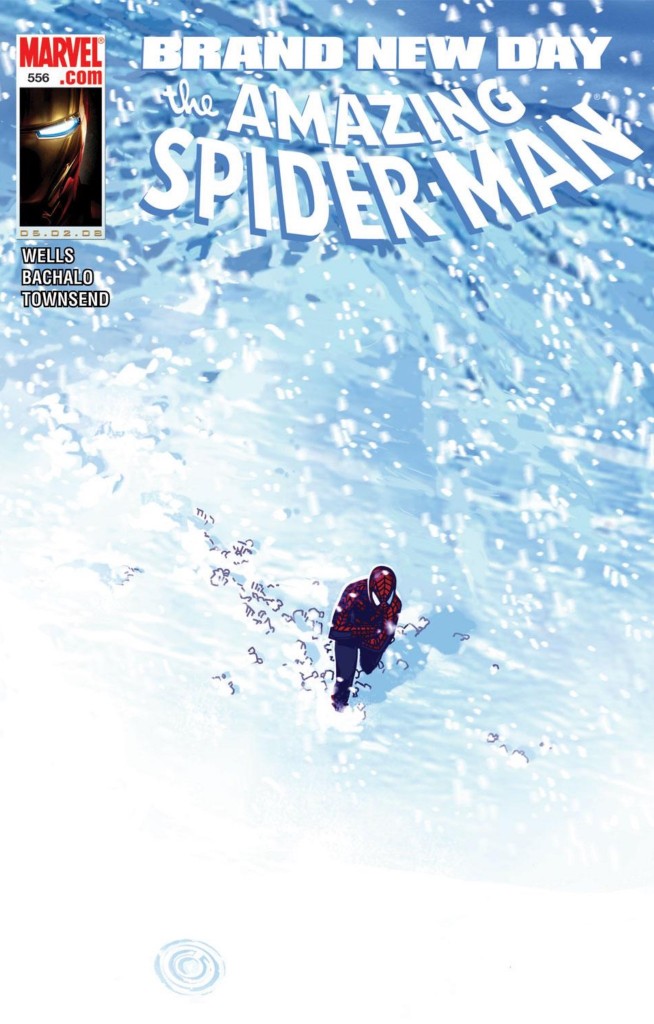
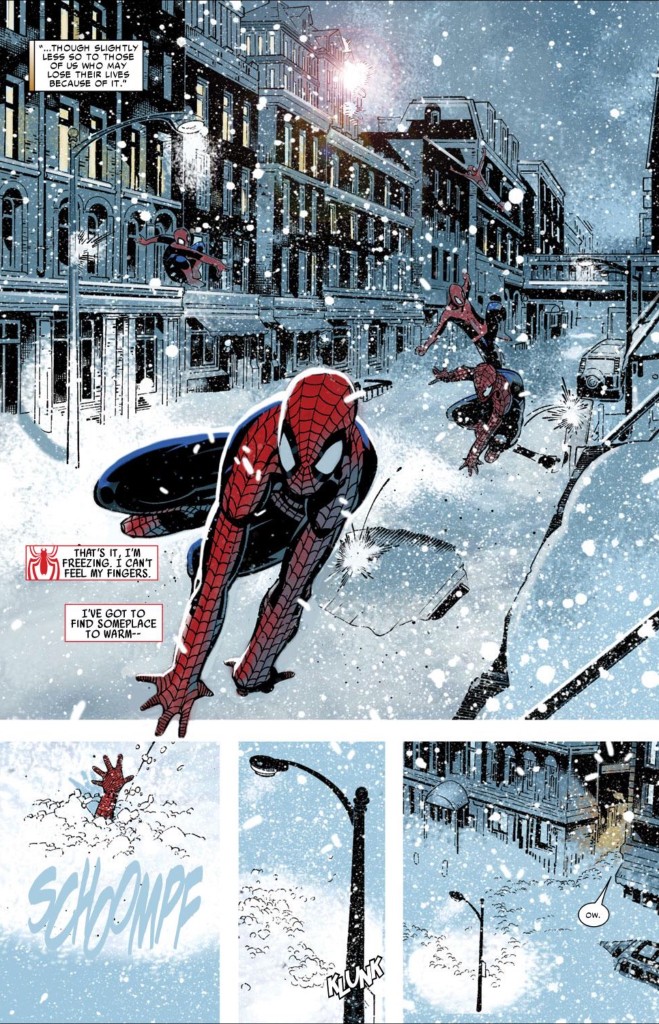
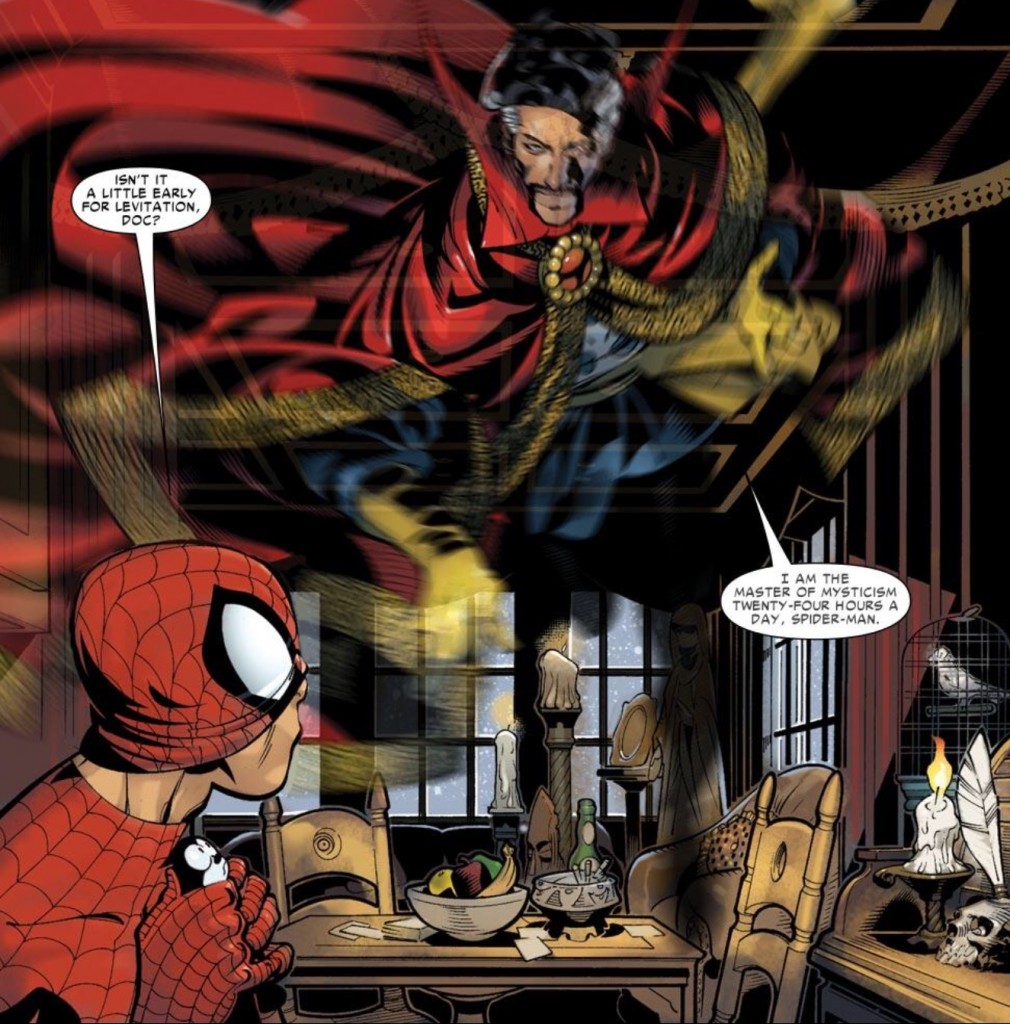
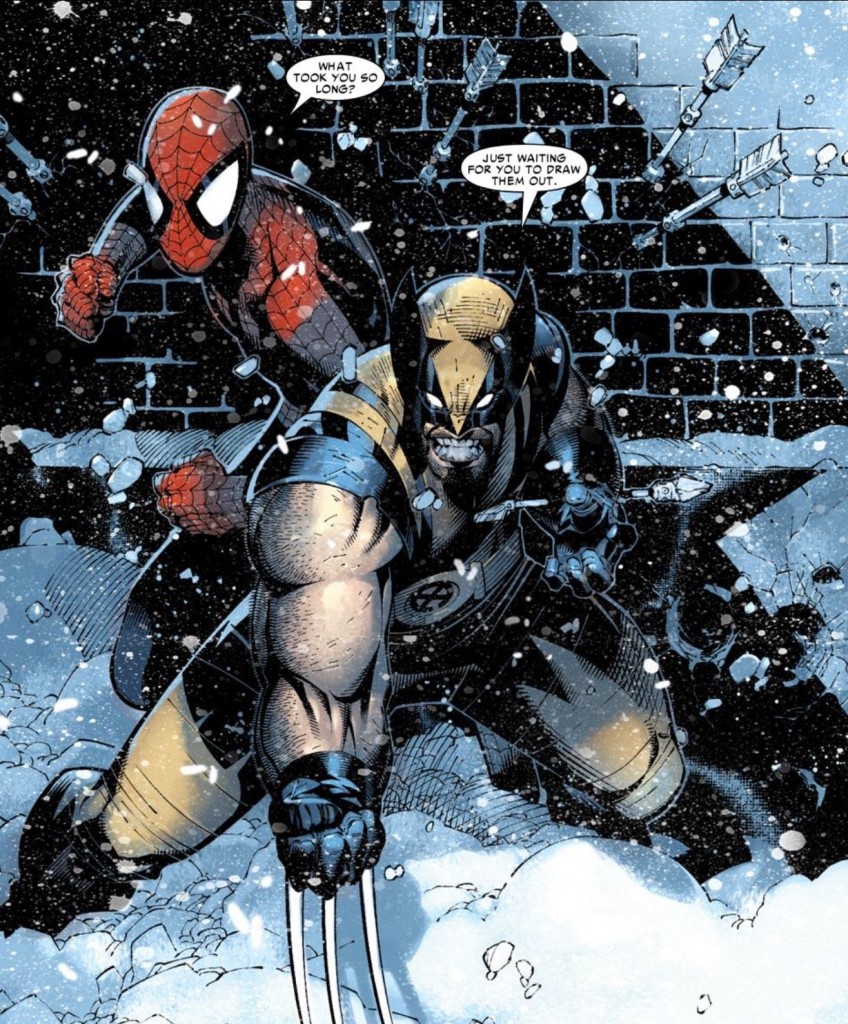
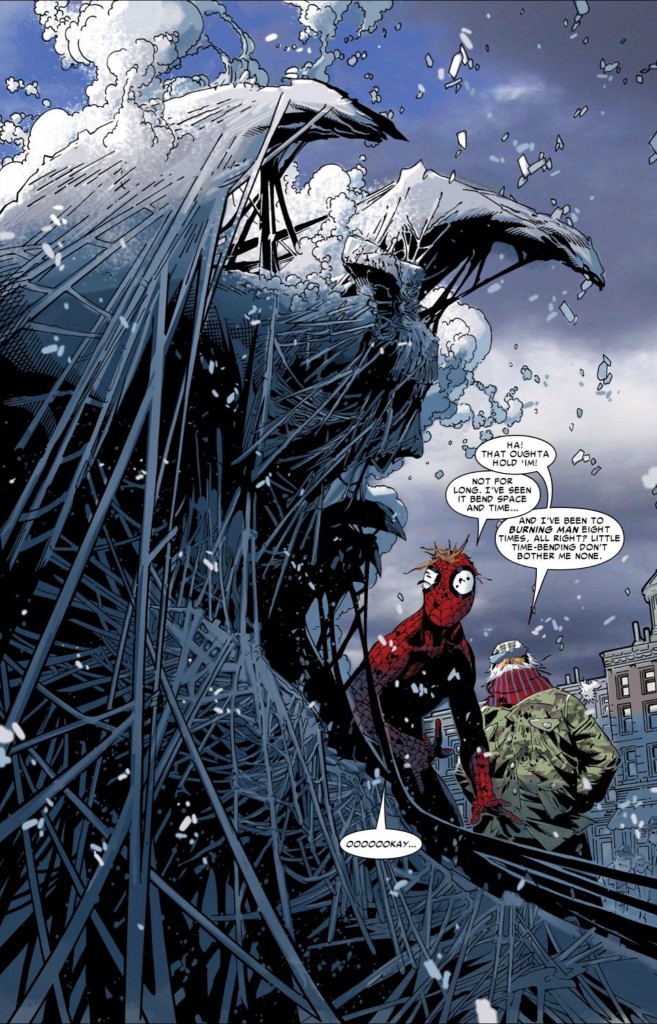

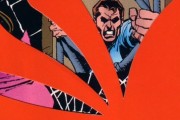
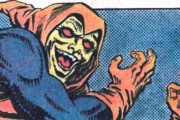
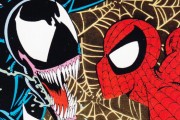
True, this story doesn’t move the main subplots the way the other three did, but frankly 2/3rds of those stories weren’t even good comics to me. If I had to choose between a superbly well-executed Spidey story with little main plot movement or a fiercely mediocre one that moved the beats along…well, its not much of a choice at all, really.
You talk a lot about the writing and the plot, but I think what really makes this work is the art. Comics are a visual medium, and their power comes from the marriage of words and pictures. Bachalo is really fantastic here in displaying a wide range of emotions the script needs to get across. The way he uses all the negative space to emphasize the wilderness of the cold as Spider-Man runs of to save the van in the cliffhanger. The way he slowly rotates our perspective on Spider-Man until we see him hanging upside down in the beginning of the second issue. The way he has the big Mayan God crossing panels and borders to attack Spider-Man from nowhere its such a wonderful trick and you can only do it in comics. “TIME CAN NOT HOLD ME”. The way he draws fat Spidey with all the paper stuffed in his suit, or the way his shifts the coloring in the police station to reflect the mood, the brightness of Carlie/Vin’s interactions and the brown/black/red of the prisoners being murdered. Even if you had some reservations about the plot, the storytelling is simply on another level from the first three stories, which seemed to all have a safe “house style” to follow.
The only problem I have with this story is Peter having a Yankees jacket. Everybody knows Peter is a Mets fan!
I hear ya, but keep in mind that as a writer (not just on this blog but in my real life job), I’m always going to value the construction of a narrative and its ability to build on itself (if that’s when it aims to do) over the visual end. I understand that comics are a visual medium, but when I put on my analysis hat, I’m always going to look to dissect the writing first. It’s just what I do.
I understand. Its just such a prevalent mentality in comic criticism, and it bugs me a bit. The bulk of the review will be a plot synopsis or talking about WHAT happens, but you rarely get a sense of HOW it happens. At best, you’ll get a cursory paragraph slapped on at the end, like “oh yeah, and the art was nice, solid. Anyway, 4 out of 5 stars”. Either they don’t have the vocabulary(which isn’t really an excuse, you’re a writer aren’t you), or they don’t think about is(which is weird to me but it happens). People always put the writers name first, even if the artist is doing the bulk of the storytelling. They say things like “Jason Aaron’s Scalped” even though RM Guera is the workhorse making those 22 pages a month look so killer. Jason Aaron was launched into superstardom, writing Marvel events and million-selling Star Wars comics, RM Guera is…man who knows.
Its just unbalanced, is all. I try every little thing to try and fix that imbalance in how we talk about comic books juuuuust a little bit.